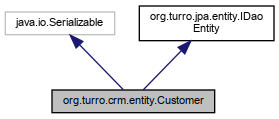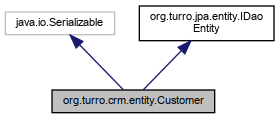- Author
- llturro
Definition at line 18 of file Customer.java.
◆ collections()
| Collection<Collection> org.turro.crm.entity.Customer.collections |
( |
| ) |
|
◆ entityId()
| Object org.turro.crm.entity.Customer.entityId |
( |
| ) |
|
◆ getActivitySectors()
| Set<ActivitySector> org.turro.crm.entity.Customer.getActivitySectors |
( |
| ) |
|
◆ getCustomerSectors()
| Set<ActivitySector> org.turro.crm.entity.Customer.getCustomerSectors |
( |
| ) |
|
◆ getIContact()
| IContact org.turro.crm.entity.Customer.getIContact |
( |
| ) |
|
Definition at line 133 of file Customer.java.
134 if(_contact ==
null) {
135 _contact = Contacts.getContactById(idContact);
◆ getId()
| long org.turro.crm.entity.Customer.getId |
( |
| ) |
|
◆ getIdContact()
| String org.turro.crm.entity.Customer.getIdContact |
( |
| ) |
|
◆ getName()
| String org.turro.crm.entity.Customer.getName |
( |
| ) |
|
◆ getOwnedBy()
◆ getSaleProspects()
| Set<SaleProspect> org.turro.crm.entity.Customer.getSaleProspects |
( |
| ) |
|
◆ getTechnologies()
| Set<Technology> org.turro.crm.entity.Customer.getTechnologies |
( |
| ) |
|
◆ isEmpty()
| boolean org.turro.crm.entity.Customer.isEmpty |
( |
| ) |
|
◆ setActivitySectors()
| void org.turro.crm.entity.Customer.setActivitySectors |
( |
Set< ActivitySector > |
activitySectors | ) |
|
Definition at line 50 of file Customer.java.
51 this.activitySectors = activitySectors;
◆ setCustomerSectors()
| void org.turro.crm.entity.Customer.setCustomerSectors |
( |
Set< ActivitySector > |
customerSectors | ) |
|
Definition at line 58 of file Customer.java.
59 this.customerSectors = customerSectors;
◆ setIContact()
| void org.turro.crm.entity.Customer.setIContact |
( |
IContact |
contact | ) |
|
Definition at line 140 of file Customer.java.
142 idContact = _contact !=
null ? _contact.
getId() :
null;
143 name = _contact !=
null ? _contact.
getName() :
null;
◆ setId()
| void org.turro.crm.entity.Customer.setId |
( |
long |
id | ) |
|
◆ setIdContact()
| void org.turro.crm.entity.Customer.setIdContact |
( |
String |
idContact | ) |
|
Definition at line 74 of file Customer.java.
75 this.idContact = idContact;
void setIContact(IContact contact)
◆ setName()
| void org.turro.crm.entity.Customer.setName |
( |
String |
name | ) |
|
◆ setOwnedBy()
| void org.turro.crm.entity.Customer.setOwnedBy |
( |
Set< CustomerOwner > |
ownedBy | ) |
|
◆ setSaleProspects()
| void org.turro.crm.entity.Customer.setSaleProspects |
( |
Set< SaleProspect > |
saleProspects | ) |
|
Definition at line 100 of file Customer.java.
101 this.saleProspects = saleProspects;
◆ setTechnologies()
| void org.turro.crm.entity.Customer.setTechnologies |
( |
Set< Technology > |
technologies | ) |
|
Definition at line 108 of file Customer.java.
109 this.technologies = technologies;
The documentation for this class was generated from the following file:


 Public Member Functions inherited from org.turro.jpa.entity.IDaoEntity
Public Member Functions inherited from org.turro.jpa.entity.IDaoEntity



